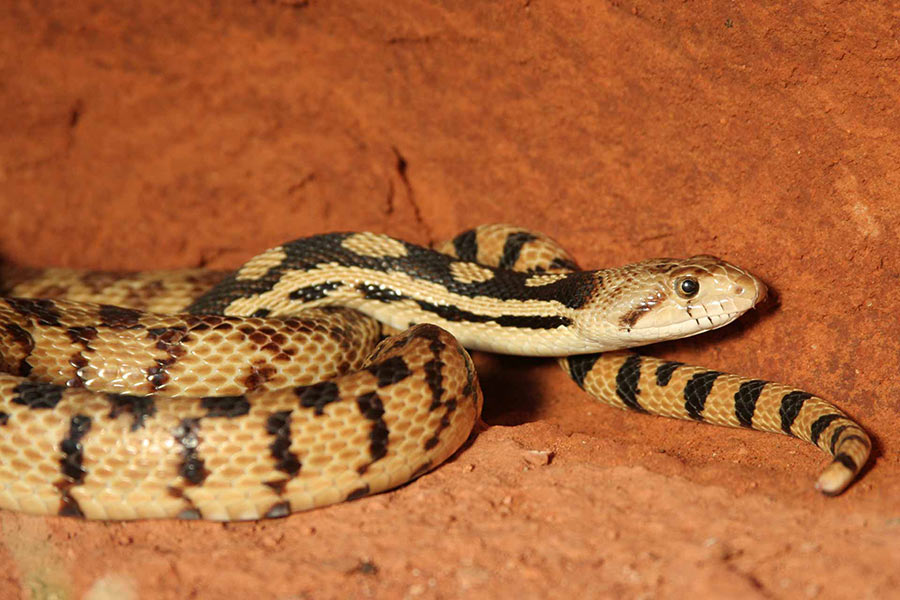≡
Utah's Reptiles and Amphibians Online Guidebook
What you need to do if you want to collect or possess reptiles or amphibians in Utah.
Are you interested in collecting or possessing lizards, snakes and frogs? Starting in 2020, Utah has new rules that oversee the state's reptiles and amphibians.
Depending on the species you're interested in — and what you plan to do with them — you may need a special permit or document in order to collect or keep certain animals.
Here are the next steps:
- Find out if you need a collection permit or other documentation
- Take the Utah reptile and amphibian orientation course
- Obtain a collection permit or certificate of registration
- See which species you can keep and how many you can keep
- Learn about prohibited species and rattlesnakes
- Collect reptiles and amphibians ethically and responsibly
- Complete the mandatory reporting requirement
Important: Once you remove any reptile or amphibian species from the wild — whether it's non-native or native — it may not be released back into the wild.
Things to keep in mind
These webpages are not a comprehensive guide to all of the relevant rules and regulations that oversee the take, possession, importation, possession and breeding of reptiles and amphibians.
In addition to reviewing these pages and completing the online course, you should read the relevant administrative rules, including the rule for amphibian and reptile collection, importation, transportation, and possession.
Below are a few of the other things you should know before you keep any wild-caught reptiles and amphibians:
- Selling wild-caught reptiles or amphibians (whether alive or dead) is illegal.
- Selling the offspring of wild-caught reptiles and amphibians is legal, but you must comply with certain sale restrictions that are defined in administrative rule R657-53.
- Reptiles may not be collected on private property without written permission from the landowner.
- Collecting reptiles and amphibians is prohibited within national parks, federal and state wildlife refuges and tribal lands.
- No permit is required to catch, photograph and immediately release reptiles and amphibians where you find them.
- It is illegal to collect, take or possess any species categorized as prohibited.
- The online course and associated collection permit do not authorize anyone to legally harvest and keep rattlesnakes or any venomous reptiles. Those activities require special permission in the form of a certificate of registration.
- If you possess a reptile and amphibian collection permit, you must also complete the mandatory online reporting within 72 hours of taking any controlled reptile or amphibian from the wild. (See the list of controlled amphibians and reptiles.)
- You must retake the online course once every three years if you intend to take reptiles or amphibians from the wild.
- The collection permit is a 365-day permit.
Permit fees
| Permit | Fee |
|---|---|
| Herpetology collection | $10 |
Know the rules
These online pages summarize some of Utah's reptile and amphibian laws and rules.
Under many of the headings on these pages, you'll see code references — such as Utah Code § 23-20-25 and Utah Administrative Rule R657-53-4 — that are linked to the detailed statute or rule that underpins the summary. If you have questions about a particular subject, take a minute to click the links and read the rules.
You are also welcome to call or visit the nearest DWR office if you have additional questions. For an in-depth look at all of Utah's wildlife laws and rules, visit the Utah Division of Wildlife Resources Administrative Rules web page.
Who makes the rules?
The Utah Wildlife Board passes the rules and laws summarized in this guidebook.
There are seven board members, and each serves a six-year term. Appointed by the governor, board members are not DWR employees.
The DWR's director serves as the board's executive secretary but does not have a vote on wildlife policies.
Before board members make changes to wildlife rules, they listen to recommendations from DWR biologists. They also receive input from the public and various interest groups via the regional advisory council (RAC) process.
If you have feedback or suggestions for board members, you can find their contact information online.
Wildlife board members
- Randy Dearth — Chair
- Gary Nielson — Vice Chair
- Justin "J" Shirley — DWR Director & Executive Secretary
- Kent Johnson
- Paula Richmond
- Bret Selman
- Bryce Thurgood








